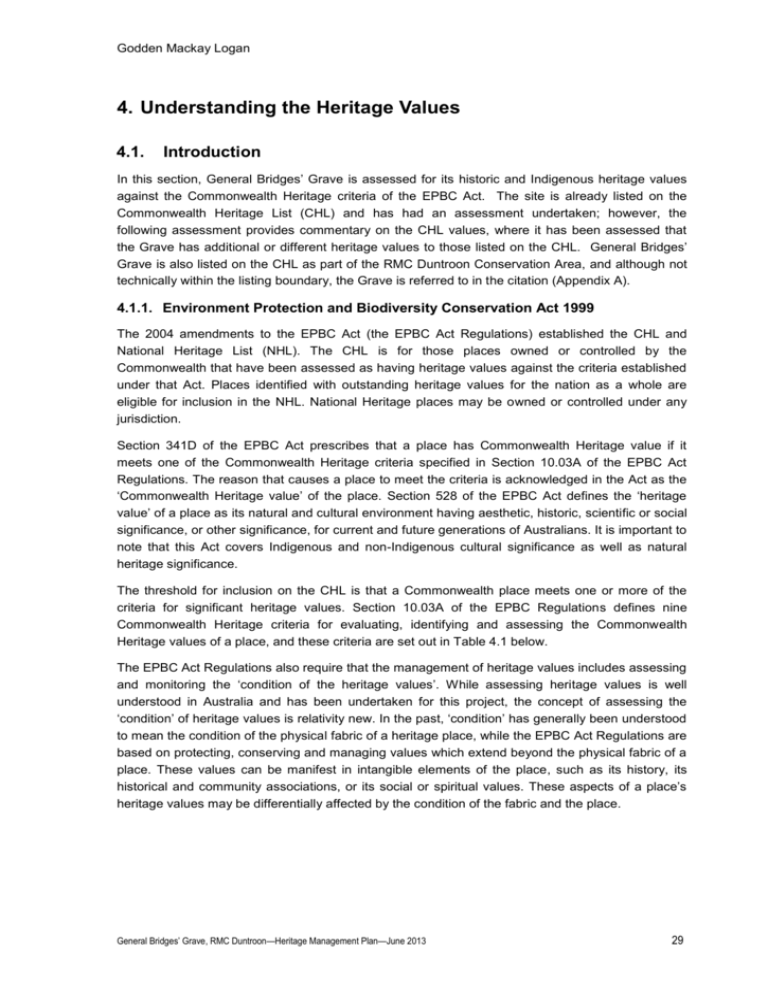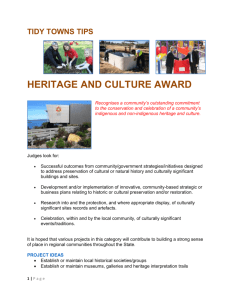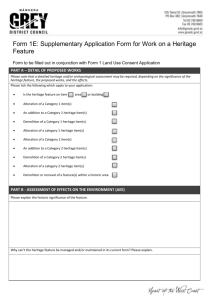04 General Bridges Grave HMP - Heritage Values
advertisement

Godden Mackay Logan 4. Understanding the Heritage Values 4.1. Introduction In this section, General Bridges’ Grave is assessed for its historic and Indigenous heritage values against the Commonwealth Heritage criteria of the EPBC Act. The site is already listed on the Commonwealth Heritage List (CHL) and has had an assessment undertaken; however, the following assessment provides commentary on the CHL values, where it has been assessed that the Grave has additional or different heritage values to those listed on the CHL. General Bridges’ Grave is also listed on the CHL as part of the RMC Duntroon Conservation Area, and although not technically within the listing boundary, the Grave is referred to in the citation (Appendix A). 4.1.1. Environment Protection and Biodiversity Conservation Act 1999 The 2004 amendments to the EPBC Act (the EPBC Act Regulations) established the CHL and National Heritage List (NHL). The CHL is for those places owned or controlled by the Commonwealth that have been assessed as having heritage values against the criteria established under that Act. Places identified with outstanding heritage values for the nation as a whole are eligible for inclusion in the NHL. National Heritage places may be owned or controlled under any jurisdiction. Section 341D of the EPBC Act prescribes that a place has Commonwealth Heritage value if it meets one of the Commonwealth Heritage criteria specified in Section 10.03A of the EPBC Act Regulations. The reason that causes a place to meet the criteria is acknowledged in the Act as the ‘Commonwealth Heritage value’ of the place. Section 528 of the EPBC Act defines the ‘heritage value’ of a place as its natural and cultural environment having aesthetic, historic, scientific or social significance, or other significance, for current and future generations of Australians. It is important to note that this Act covers Indigenous and non-Indigenous cultural significance as well as natural heritage significance. The threshold for inclusion on the CHL is that a Commonwealth place meets one or more of the criteria for significant heritage values. Section 10.03A of the EPBC Regulations defines nine Commonwealth Heritage criteria for evaluating, identifying and assessing the Commonwealth Heritage values of a place, and these criteria are set out in Table 4.1 below. The EPBC Act Regulations also require that the management of heritage values includes assessing and monitoring the ‘condition of the heritage values’. While assessing heritage values is well understood in Australia and has been undertaken for this project, the concept of assessing the ‘condition’ of heritage values is relativity new. In the past, ‘condition’ has generally been understood to mean the condition of the physical fabric of a heritage place, while the EPBC Act Regulations are based on protecting, conserving and managing values which extend beyond the physical fabric of a place. These values can be manifest in intangible elements of the place, such as its history, its historical and community associations, or its social or spiritual values. These aspects of a place’s heritage values may be differentially affected by the condition of the fabric and the place. General Bridges’ Grave, RMC Duntroon—Heritage Management Plan—June 2013 29 Godden Mackay Logan Table 4.1 Commonwealth Heritage criteria (Note: National Heritage Criteria are identical except where CHL places have ‘significant heritage value’ NHL places have ‘outstanding heritage value’) Commonwealth Heritage Criteria Criterion A— Processes The place has significant heritage value because of the place's importance in the course, or pattern, of Australia's natural or cultural history. Criterion B— Rarity The place has significant heritage value because of the place's possession of uncommon, rare or endangered aspects of Australia's natural or cultural history. Criterion C— Research The place has significant heritage value because of the place's potential to yield information that will contribute to an understanding of Australia's natural or cultural history. Criterion D— Characteristic The place has significant heritage value because of the place's importance in demonstrating the principal characteristics of: a class of Australia's natural or cultural places; or a class of Australia's natural or cultural environments Criterion E— Aesthetic The place has significant heritage value because of the place's importance in exhibiting particular aesthetic characteristics valued by a community or cultural group. Criterion F— Technical/Achiev ement The place has significant heritage value because of the place's importance in demonstrating a high degree of creative or technical achievement at a particular period. Criterion G— Social The place has significant heritage value because of the place's strong or special association with a particular community or cultural group for social, cultural or spiritual reasons. Criterion H— Associative The place has significant heritage value because of the place's special association with the life or works of a person, or group of persons, of importance in Australia's natural or cultural history. Criterion I— Indigenous The place has significant heritage value because of the place's importance as part of Indigenous tradition. 4.2. Assessment of Heritage Values of General Bridges’ Grave 4.2.1. Official Commonwealth Summary Statement of Significance The CHL recognises places of Commonwealth Heritage value which are owned by the Commonwealth Government. General Bridges’ Grave is entered in the CHL, is mentioned CHL citation for the RMC Duntroon Conservation Area, and the requirements of the EPBC Act therefore apply. The following summary statement of significance has been reproduced from the official Commonwealth Heritage Listing for General Bridges’ Grave, Place ID 105439 from the Australian Heritage Database. The Memorial Grave of Brigadier-General Bridges, designed by architect Walter Burley Griffin in 1916 and completed in 1920, is important as a memorial to the first Commandant of Australia's first Military College. The new Military College was established in October 1910 at Duntroon, a site selected by Bridges. As Major General, Bridges was commander of the Australian Imperial Force which landed at Gallipoli in April 1915. On the morning of 15 May 1915 Bridges was shot by a sniper in Monash Valley. Bridges died en route to Egypt on 18 May 1915. (Criteria A.4 and H.1) Historic Themes: 7.4 Federating Australia, 7.7 Defending Australia, 8.8 Honouring the fallen, 9.7 Dying. The Memorial Grave is important for its symbolic, cultural and social associations as part of the landscape setting of Duntroon and the history of Australia's defence forces. (Criterion G.1) The Memorial Grave is important for its aesthetic characteristics which draw on the prevailing ideas for war 30 General Bridges’ Grave, RMC Duntroon—Heritage Management Plan—June 2013 Godden Mackay Logan memorials of the period and for the design concept which draws on the ceremonial aspects of military parade grounds. (Criterion E.1) 4.2.2. Identified Commonwealth Heritage Values The official Commonwealth Heritage Values for General Bridges’ Grave are listed in Table 4.2 below. The Grave is currently listed under Criteria A, E, G and H; however; the existing Commonwealth Heritage assessment should be re-nominated to ensure the identified gaps in the CHL citation and changes that have occurred over time are formally included in the citation. Further evidence and assessment statements to validate the assessment against each additional criterion are provided in Table 4.2 below. The original, official listed citation text is included in italics and additional text has been provided under each criterion. From a greater understanding of the historical and physical context of the place as outlined in Sections 2.0 and 3.0 this assessment has found that General Bridges’ Grave has values under Criterion B Rarity, as one of only two soldiers whose remains were brought back to Australia after they died in war overseas and as one of only two examples of graves designed by Walter Burley Griffin. Further evidence to validate the assessment against this criterion is provided in Table 4.2 below. The CHL Citation for the RMC Duntroon Conservation Area considered General Bridges’ Grave as significant under Criterion H as an attribute of Duntroon’s association with significant people including General Bridges. However the Grave is not included in the listing boundary of the Conservation Area. Table 4.2 Commonwealth Heritage criteria and identified heritage values of General Bridges’ Grave. NB: Responses in italics are directly from the CHL citation, those in normal text are revised assessments. Criteria Identified Values Criterion A— Processes General Bridges’ Grave is significant as the last resting place of the founder of the Royal Military College (RMC) at Duntroon. Major General William Throsby Bridges was appointed the first Commandant of the College with the rank of Brigadier General and planned and established the RMC at Duntroon. On active service in Gallipoli in 1915, Bridges was mortally wounded and died on the hospital ship Gascon. After burial in Egypt, Bridges’ body brought back to Australia for a State memorial service and ceremonial burial overlooking Duntroon. Attributes The whole of the memorial gravesite, associated plantings and its filtered view through the woodland over RMC Duntroon General Bridges’ Grave, RMC Duntroon—Heritage Management Plan—June 2013 31 Godden Mackay Logan Criteria Identified Values Criterion B— General Bridges’ Grave is significant as one of only two graves for soldiers who died overseas during World War I and whose remains were brought back for State burial in Australia. The other is that of the unknown soldier at the Australian War Memorial, whose remains were returned to Australia in 1993. Furthermore, Bridges’ faithful horse ‘Sandy’ was the only horse to be returned to Australia following the War. Rarity The practice of repatriation of Australians killed overseas in active service not usual in Australia, and shows Bridges’ significance as a historical figure. Walter Burley Griffin, the celebrated Federal Capital Director of Design and Construction, who designed the plan of Canberra, also designed the tomb surmounting the Grave. It is one of only two graves designed and built by Griffin in Australia and the only permanent structure designed by Griffin still extant in Canberra. Attributes The whole of the memorial gravesite particularly the tomb stone with its inlaid sword and associated plantings. Criterion C— Research General Bridges’ Grave does not meet this criterion. Criterion D— Characteristic General Bridges’ Grave does not meet this criterion. Criterion E— Aesthetic characteristics The simple and dignified design of the memorial tombstone by Walter Burley Griffin was greatly influenced by Lady Bridges and her preference for simplicity. The simplicity of the Grave’s design is further enhanced by its immediate setting with a simple fence and four pencil pines geometrically aligned in each corner of the Grave which may represent a four man sentry, as occurred at the funeral of Major General Bridges. The Grave’s location on the slope of Mt Pleasant overlooking RMC Duntroon and the wider landscape of Canberra add considerably to its aesthetic values. The area is valued highly by veterans, current Defence personnel, as well as residents of RMC Duntroon. Attributes The Grave's architectural characteristics and its surrounding restrained landscaping and views across the site of the RMC. Criterion F— Creative/Technical General Bridges’ Grave does not meet this criterion. Criterion G— Social value The Memorial Grave is important for its symbolic, cultural and social associations as part of the landscape setting of Duntroon and the history of Australia's defence forces. The Grave is a monument important for its symbolic and cultural associations and has social value for military personnel, past and present, at Duntroon. Attributes The whole of the memorial grave within its landscape setting. 1 32 General Bridges’ Grave, RMC Duntroon—Heritage Management Plan—June 2013 Godden Mackay Logan Criteria Identified Values Criterion H— Significant people The Memorial Grave of Major General Bridges is important as a memorial to the first Commandant of Australia's first Military College. The Grave is also important for its strong associations with Walter Burley Griffin who designed the memorial in close consultation with Bridges widow Lady Edith Bridges. This is the only permanent structure designed by Griffin in Canberra. Attributes The grave's architectural characteristics, which highlight its association with Walter Burley Griffin, plus the memorial, which illustrates its association with Major General Bridges 2 Criterion I— Indigenous General Bridges’ Grave does not meet this criterion. 4.2.3. Indigenous Heritage Values Indigenous heritage values are assessed for their cultural significance and their scientific significance. Cultural significance is assessed by the Indigenous community and relates to the historical and pre-historical landuse of an area, along with stories, mythologies and traditions relating to the site and its broader landscape and cultural context. Scientific significance is generally assessed by archaeologists and relates to the archaeological resources on the site, including surface artefacts and also the potential for buried artefacts. The cultural significance of the General Bridges’ Grave site was discussed with members of the Indigenous community. In general, it was agreed that the overall landscape of the site and its surrounds, including the area of RMC Duntroon, Mt Pleasant and the associated areas of the Molonglo and Majura Valleys, would have been of significance to Aboriginal people in the past. This significance is based on an understanding of the way the landscape would have been used and its proximity to important resources such as the Molonglo River and also the vantage point of Mt Pleasant. It was also part of a landscape of tracks and trails leading to the Molonglo River from the north of what is now Canberra. However, recent alterations to the landscape from the establishment of the RMC Duntroon facility and the surrounding suburbs of Canberra have resulted in this significance no longer being realisable. It is not considered to retain any significant Indigenous cultural values. The site is considered to have very low archaeological potential and therefore is not considered to be of scientific significance based on archaeological values. The action of disturbing the ground to establish the Grave and its setting is also considered to have lessened the archaeological potential of the site. 4.2.4. Revised Statement of Significance The memorial Grave, designed by architect Walter Burley Griffin in consultation with Bridges widow Lady Edith Bridges in 1916, and completed in 1920, is important as the final resting place of (and a memorial to) the first Commandant of Australia's first Military College, Major General Sir William Throsby Bridges. Bridges established Australia’s first RMC in 1910 at Duntroon, a site he selected and planned. As Major General, Bridges was commander of the Australian Imperial Force which General Bridges’ Grave, RMC Duntroon—Heritage Management Plan—June 2013 33 Godden Mackay Logan landed at Gallipoli in April 1915. On the morning of 15 May 1915 Bridges was mortally wounded and died en route to Egypt on 18 May 1915 aboard the hospital ship Gascon. The Memorial Grave is considered rare as the only example of a permanent structure designed by prominent architect Walter Burley Griffin in Canberra, and as one of only two tombs in Australia of World War I soldiers who were exhumed overseas and repatriated to Australia. The practice of repatriation of General Bridges was highly unusual and unique at this time, and preluded a shift in attitudes in commemoration of war dead. The Memorial Grave is important for its symbolic, cultural and social associations as part of the landscape setting of Duntroon and the history of Australia's defence forces. The Memorial Grave is also important for its aesthetic characteristics as a simple and dignified memorial, enhanced by the use of rosemary and pencil pines, symbolically associated with remembrance. 4.2.5. Discussion of Identified Heritage Values The verification of CHL heritage values undertaken for this HMP has demonstrated that General Bridges Grave meets five of the CHL Criteria, one more than the current CHL listed values. From an understanding of the historical and physical context of the place and the heritage assessment above, the Grave has been assessed as significant under Criterion B—Rarity in addition to the already recognised Criterion A—Processes, E—Aesthetic, G—Social and H—Associative. The verification has also found that General Bridges’ Grave has the potential to meet the criteria for National Heritage Listing, as it has been assessed as likely to be of ‘outstanding’ heritage value to the Nation under Criteria A—Historic, B—Rarity, H—Associative, pending a detailed comparative analysis of other memorial graves and commemorative sites for WWI soldiers in Australia and beyond. The revised assessment provides the NCA with a comprehensive understanding of the heritage values for General Bridges Grave; this in turn provides a basis for appropriate management policies to be developed (Section 5.0) and prepared (Section 6.0) for the site. 4.2.6. Condition of Heritage Values The condition of the Commonwealth Heritage values of General Bridges’ Grave has a direct correlation with the condition of the significant fabric of the Grave. However, at General Bridges’ Grave, heritage values are also embodied in the non-physical setting—including the significant social connections and associations of the place. In effect this means conserving values that extend beyond the physical fabric of a place, as well as caring for fabric which gives rise to heritage values. For example, the condition of the heritage values of General Bridges’ Grave would be diminished by the removal of any elements of the Grave or its setting. Likewise the social and associational values held by the community for General Bridges’ Grave can only be conserved and nurtured by continued access, promotion and understanding of the site, its history and its significance. The concept of reporting on ‘the condition of heritage values’ is relatively new and the requirement for the assessment and monitoring of the condition of heritage values in management of heritage places is embodied in the EPBC Act provisions. Managers of heritage places are still coming to terms with the best means to assess and monitor the condition of identified heritage values, and a best-practice approach is still evolving. Verification of previous assessments against CHL criteria is one of the ways in which it is possible to monitor ‘the condition of heritage values’ over time. 34 General Bridges’ Grave, RMC Duntroon—Heritage Management Plan—June 2013 Godden Mackay Logan The EPBC Act Regulations Schedule 7A, governing management plans for Commonwealth Heritage places, requires that such plans include a description of the Commonwealth Heritage values and their condition. In addition, the management of the Commonwealth Heritage values should provide for regular monitoring and reporting on the conservation of the Commonwealth Heritage values, which relies on an understanding, measuring and monitoring of the condition of those values. There are links between the condition of the Commonwealth Heritage values and the condition of significant fabric, although it is not synonymous. In Australia, condition is a measure of the deterioration of a place or site, and thus its ability to survive into the future without remedial action being required. It should not be used interchangeably with integrity. Some structures have extraordinary authenticity and integrity, but may be in very poor condition. The two terms are explained thus: authenticity—their cultural values are truthfully and credibly expressed through their attributes of form, design, materials, techniques and management systems, location and setting—an authentic place is the honest product of its history and of historical processes; and integrity—inclusion of all elements necessary to express heritage values are of adequate size to ensure the complete representation of the features and processes which convey significance, and with no inappropriate development with adverse effect to heritage values— integrity is a measure of the wholeness and intactness of the place and its attributes. The condition of both the fabric and the Commonwealth Heritage values at General Bridges’ Grave is good and the site maintains a level of significance well above the threshold for listing on the CHL. To maintain the condition of the Grave and its values, regular maintenance and conservation must be undertaken, including ensuring the area is free from debris and monitoring the condition of the granite. 4.2.7. Historic Themes The Commonwealth has developed a framework of ‘Australian Historic Themes’ to assist with identifying, assessing, interpreting and managing heritage places and their values. Using historic themes can assist with focusing on the historical values of a place and how these values are represented physically in the place and/or wider context. The Australian Historic Themes provide a context for assessing heritage values. The themes are linked to human activities in their environmental context. Themes link places to the stories and processes which formed them, rather than to the physical ‘type’ of place represented. Australian Historic Themes are grouped together by an overarching historic theme, which is further divided into more specific themes and sub-themes. Historic Theme Groups are listed in Table 4.3 below. These historic themes are useful in interpreting the site, and grouping similar sites together for thematic studies or interpretation. Table 4.3 Australian Historic Theme Groups Number Historic Theme Group 1 Tracing the Evolution of the Australian Environment 2 Peopling Australia General Bridges’ Grave, RMC Duntroon—Heritage Management Plan—June 2013 35 Godden Mackay Logan Number Historic Theme Group 3 Developing Local, Regional and National Economies 4 Building Settlements, Towns and Cities 5 Working 6 Educating 7 Governing 8 Developing Australia’s Cultural Life 9 Marking the Phases of Life The following Australian Historic Themes apply to General Bridges’ Grave: Historic Theme Group 7—Governing Historic Theme 7.4 Federating Australian Historic Theme—7.7 Defending Australia 7.7.1 Providing for the common Defence 7.7.3 Going to war Historic Theme Group 8—Developing Australia’s Cultural Life Historic Theme—8.8 Remembering the fallen Historic Theme—8.9 Commemorating significant events Historic Theme Group 9—Marking the Phases of Life Historic Theme—9.7 Dying 9.7.1 Dealing with human remains 9.7.2 Mourning the dead 9.7.3 Remembering the dead 4.3. Ranking of Significance 4.3.1. Explanation of Heritage Significance Ranking Various elements and attributes of General Bridges’ Grave contribute to the overall value of the structure to a greater or lesser degree. The purpose of understanding the significance of the Grave and its elements is to enable a flexible approach to the management of the place. Following the benchmark approach set out by JS Kerr in The Conservation Plan, the significance of General Bridges’ Grave and its elements have been assessed by considering the independent value of the element to the whole site.3 36 General Bridges’ Grave, RMC Duntroon—Heritage Management Plan—June 2013 Godden Mackay Logan Table 4.4 Definition of the ranking, or grades, of heritage significance used in this HMP. Ranking Explanation of the Heritage Significance Ranking/ Grade Exceptional Rare or outstanding site that significantly embodies and demonstrates Commonwealth Heritage values in its own right and makes a direct and irreplaceable contribution to a place’s significance/value. Generally these elements include a high degree of original fabric or attributes with heritage values and includes non-tangible components such as views and functional relationships which directly contribute to their outstanding/exceptional values. These may include some alterations which are of a minor nature and do not detract from significance. Loss or alteration would significantly diminish the Commonwealth (or other) Heritage values of the place. High Site that demonstrates Commonwealth Heritage values in its own right and makes a significant contribution to the place’s heritage value. Existing alterations do not detract from its heritage values. Loss or unsympathetic alteration would diminish the Commonwealth Heritage values of the place. Moderate Site that reflects some Commonwealth (or other local) Heritage values but only contributes to the overall significance/values of the place in a moderate way. Loss or unsympathetic alteration is likely to diminish the Commonwealth Heritage values of the place. Low Site that reflects some (or a low level) Commonwealth Heritage values and only contributes to the overall significance/values of the place. Loss will not diminish the Commonwealth or local Heritage values of the place. Neutral Site that does not reflect or demonstrate any Commonwealth or local Heritage values nor detracts from the overall heritage values of the place. Does not fulfil criteria for heritage listing. Intrusive Damaging to the place’s heritage values. Loss may contribute to the Commonwealth Heritage values of the places. Does not fulfil criteria for heritage listing. 4.3.2. Application of Heritage Significance Rankings to General Bridges’ Grave The purpose of understanding the significance of the various elements is to enable a flexible approach to the management of the structure. The whole structure and individual elements of General Bridges’ Grave have their rankings outlined in Table 4.5 below: Table 4.5 Heritage ranking applied to elements of General Bridges’ Grave. Element Ranking of Significance General Bridges’ Grave (whole) Exceptional (potential for National heritage value) Granite Tomb Exceptional Griffin design Exceptional Form Exceptional Fabric Exceptional Immediate Setting (gravel, pencil pines and fencing) High Aleppo Pines Significance—High Location—Moderate Native plantings on Mt Pleasant ridge Moderate Wider Setting (in general) Low General Bridges’ Grave, RMC Duntroon—Heritage Management Plan—June 2013 37 Godden Mackay Logan Element Ranking of Significance Asphalt and Gravel in current configuration Intrusive Significant Views High 4.4. Tolerance for Change 4.4.1. Explanation of Tolerance for Change The concept of ‘tolerance for change’ is a useful management tool which assists with managing any proposed change to a site’s heritage values, in particular the built and landscape character. Table 4.5, below, sets out the rankings for tolerance for change used in this report and explains their application to General Bridges’ Grave. The tolerance for change rankings are applied to help the NCA managers identify the extent to which they retain and/or provide important evidence of the site’s significance in its existing form, fabric, function and/or location, and the relevant degree of conservation action needed. Table 4.5 Tolerance for change explanation Tolerance for Change Definition of the Application to General Bridges’ Grave Low tolerance for change The key attributes (form, fabric, function and/or location) embody the heritage values of the component/element and its contribution the site. It retains a high degree of intactness with only very minor alterations that do not detract from significance. The key attributes should be retained and conserved. Some tolerance for change The key attributes (form, fabric, function and/or location) embody the heritage values of the component/element and its contribution to the site. It has undergone some alteration which does not detract from its significance. The key attributes should generally be retained and conserved. However they may be altered to some degree without adverse impact on heritage significance. Able to tolerate moderate change The key attributes (form, fabric, function and/or location) only partly embody the heritage values of the component/element and the site, or has been considerably modified. The key attributes should be retained and conserved. There is greater opportunity for change with less adverse impact. Able to tolerate reasonable change The key attributes (form, fabric, function and/or location) have relatively little heritage value, but contribute to the overall significance of the component/element and/or the site. Alterations detract from significance or the original attribute is difficult to interpret. Able to tolerate substantial change The key attributes (form, fabric, function and or location) have little or negligible heritage significance to the component/element or the overall site. 4.4.2. Application of Tolerance for Change Tolerance for change applied to General Bridges’ Grave has been used to identify the extent to which the place’s heritage values/significance and key attributes are able to tolerate change without adversely impacting the nature or degree of its heritage values/significance. Table 4.6 Tolerance for Change applied to elements of General Bridges’ Grave. 38 General Bridges’ Grave, RMC Duntroon—Heritage Management Plan—June 2013 Godden Mackay Logan Element Application of Tolerance for Change to General Bridges’ Grave General Bridges’ Grave (whole) Low Tolerance for Change Granite Tomb Low Tolerance for Change Griffin design Low Tolerance for Change Form Low Tolerance for Change Fabric Low Tolerance for Change Immediate Setting (gravel, pencil pines and fencing) Low Tolerance for Change Aleppo Pines Low Tolerance for Change Native plantings on Mt Pleasant ridge Some Tolerance for Change Wider Setting (in general) Reasonable Tolerance for Change Asphalt and Gravel in current configuration Reasonable Tolerance for Change Significant Views Low Tolerance for Change 4.5. 1 2 3 Endnotes Department of Sustainability, Environment, Water, Population and Communities 2004, General Bridges’ Grave, Commonwealth Heritage List Citation. Department of Sustainability, Environment, Water, Population and Communities 2004, General Bridges’ Grave, Commonwealth Heritage List Citation. Kerr, JS 1982, The Conservation Plan, National Trust of Australia. General Bridges’ Grave, RMC Duntroon—Heritage Management Plan—June 2013 39







